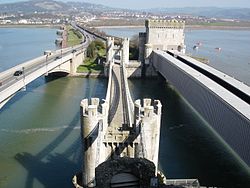Conwy Suspension Bridge | |
|---|---|
 The bridge as seen from Conwy Castle, with the modern road bridge to the left and the rail bridge to the right | |
| Coordinates | 53°16′50″N3°49′26″W / 53.2805°N 3.82382°W |
| Carries | Pedestrians |
| Crosses | River Conwy |
| Locale | Conwy |
| History | |
| Constructed by | Thomas Telford |
| Construction start | 1822 |
| Construction end | 1826 |
| Location | |
 | |

The Conwy Suspension Bridge is a Grade I-listed structure and is one of the first road suspension bridges in the world. Located in the medieval town of Conwy in Conwy county borough, North Wales, it is now only passable on foot. The bridge is now in the care of the National Trust. It originally carried the A55(T) road from Chester to Bangor.
Contents
